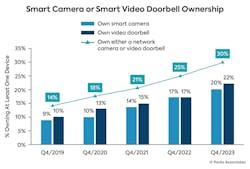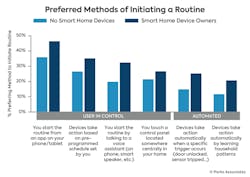The Smart Money: Smart Video, Automation, and EcoSystems
This article originally appeared in the October 2024 issue of Security Business magazine. Don’t forget to mention Security Business magazine on LinkedIn and @SecBusinessMag on Twitter if you share it.
Video doorbells and networked cameras continue to lead in the smart home. The integration of video and notifications plays a pivotal role in offering homeowners peace of mind and enhanced safety. By providing real-time visual monitoring and instant alerts, these features ensure people are informed.
Parks Associates research finds 30% of internet households own either a smart camera or a smart video doorbell. This provides a foundation for recurring services, which is critical for connected consumer products. About two-thirds of video device owners report paying for an attached service, not including those with a security system.
Video provides an opportunity for service revenues, including high-dollar services like professional monitoring. Expect more device manufacturers to add a video element to their solutions, particularly access control players.
A unified smart home experience is the goal, but fragmentation and interoperability plague the smart home ecosystem.
It is also worth noting that the market itself is heavily concentrated, with Amazon dominating the video doorbell market with both the #1 (Ring) and #2 (Blink) brands reported among recent buyers. These same two Amazon-owned brands also lead the smart camera category, though that market is more diverse, helped by the variety of use cases for cameras vs. a doorbell’s primary focus on the front entry.
The Appeal of Routines
A compelling reason to adopt the smart home beyond camera devices is the use of automation to add convenience and match tech use cases to lifestyles. These automations can be set up as routines that can trigger multiple actions based on time of day, human presence, or other criteria.
Parks Associates set out to understand what routines appealed to consumers, and what triggers they would prefer. The research found that 40% of U.S. internet households with connected home devices have at least one multi-device integration or routine established today. The remaining 60% of households with smart devices are using them as point solutions, and much of their value remains locked.
Those owning security systems are particularly likely to coordinate smart actions, with 53% of security system owners with smart home devices currently integrating multiple devices in some sort of coordinated action.
Smart access control households (those owning a smart door lock or smart garage door opener) are also more likely than the average smart device owner to have coordinated routines set in their home. Smart access routines also rank among the most appealing actions tested, where locks and garage door openers coordinate with cameras/doorbells, lights, thermostats, and security systems. These routines are designed to enhance household convenience, security, and energy efficiency.
Routines are also appealing based on certain times of the day or lifestyle factors.
Unfortunately, there is an enormous gap between the appeal of routines and actual use. 82% of U.S. internet households find a smart home device-enabled bedtime routine appealing, but just 16% of smart home device owners currently have set bedtime routines. Additionally, 65% find an entertainment routine appealing, but just 21% of device owners have set such a routine. The process for setting routines is not intuitive, made worse by the deep fragmentation of brands, ecosystems, and protocols in use across the home.
The industry is working towards making these easier. Samsung SmartThings recently announced a range of updates aimed at improving the smart home experience, including updates related to routines, such as shareable routines that allow users to distribute their automated tasks to friends or family via a QR code.
There is also potential for generative AI to help consumers more intuitively set up and start routines; however, most users prefer to manually start a routine from an app or setting a pre-programmed schedule. Smart devices and systems making decisions in an automated or predictive way distinctly lag, showing a gap between consumer comfort levels and the industry movement to AI-driven automation.
Ecosystems Remain Important
A unified smart home experience is the holy grail of convenience and value for consumers, but fragmentation and interoperability plague the smart home ecosystem. While paths exist to achieve a unified experience across some device types today through a curated, systems-based approach, most consumers buy point solutions for particular use-cases.
Entertainment, smart homes, and health devices remain siloed from each other, and smart home device owners use multiple platforms to control their devices. The more devices owned; the more control platforms are used.
Control platforms are a critical influencer on device choice, and the leading platform players that also offer branded hardware seek to create an “ecosystem” effect that encourages brand loyalty and repeat purchases. Amazon, Google, Samsung, Apple, and security systems offer the top control platforms today. When forced to pick their most used control platform, Amazon/Ring holds the top position, with its dominance holding steady the past few years, followed by Google/Nest, also tied with top security platforms), and Apple HomeKit/Siri. But other ecosystems exist with hubs that allow integrated features.
LG’s acquisition of Homey shows that the battle of platform ecosystems is far from over. LG already offers its ThingQ platform that allows LG appliance owners to control and see insights from LG smart devices; however, third-party integrations are necessary for LG to have a chance to be a lead home controller outside of its own ecosystem. The acquisition of Homey by LG has the potential to create an integrated ecosystem that could rival the big tech players.
About the Author

Daniel Holcomb
Daniel Holcomb is Senior Analyst for Parks Associates, which covers the security and smart home market extensively within its research practice. The company will host the 20th annual CONNECTIONS SUMMIT at CES Jan. 7, 2026, and the 30th annual CONNECTIONS, The Premier Connected Home Conference, on May 5-7 in Santa Clara, Calif. Visit www.parksassociates.com to learn more.

